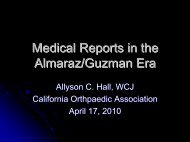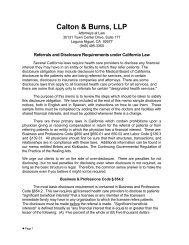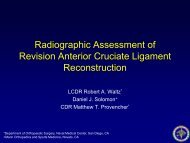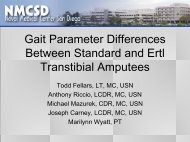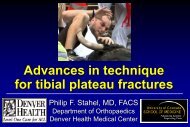Enhancing Your Practice's Revenue - California Orthopaedic ...
Enhancing Your Practice's Revenue - California Orthopaedic ...
Enhancing Your Practice's Revenue - California Orthopaedic ...
- No tags were found...
Create successful ePaper yourself
Turn your PDF publications into a flip-book with our unique Google optimized e-Paper software.
Section 2ServicesChapter 3Physical and Occupational TherapyBy Michael Q. Freehill, MD and William Evans, MBAPhysical Therapy (PT) and Occupational Therapy (OT)are crucial to successful outcomes for patients withmusculoskeletal problems, and many excellent reasonsexist to develop in-house PT/OT. However, the successof physician-owned physical therapy services (POPTS) isnot a foregone conclusion. There is an array of operational,financial and political pitfalls.Operational ConsiderationsThe impact on existing facilities and staffing is one of thefirst issues to evaluate when considering adding PT and/or OT lines of service. If sufficient unused (or at leastnon-revenue generating) space currently exists, developinga new PT/OT clinic may be fairly simple. However, ifadditional space or significant renovation is needed, costscan quickly escalate. Federal regulations, such as Stark,generally encourage PT/OT to be housed in the samebuilding as where the physician owners hold clinic, so spacelimitations can present significant obstacles unless newspace is pursued.Likewise, an evaluation of staffing and company cultureis needed. For example, the increased throughput requirementsfor the front desk may dictate that additional staffing(or even an entire front desk remodel) is necessary to addPT/OT in existing clinic locations. Further, it is uncommonto simply employ one PT without some additionalsupport, such as a PT Assistant, Aide, or perhaps a CertifiedAthletic Trainer (ATC). See Chapter 1: Non-physicianExtenders. As a result, clinics should be prepared foradditional staffing requirements. In the case of physicaltherapy, a 2:1 ratio of PTs to PT Assistants is not unreasonable,although every practice must determine its own needsbased on volume of referralsOperational questions to ask:• Do we know of existing PTs and/or OTs whom we wantto employ?• What equipment will our PT/OT require to fit ourpractice?• Do we have existing space or do we need to invest innew locations?• How many patients per day do we expect PT/OT toadd?• Does our front desk have the capability of handlingmore patients?• What other staff (e.g., billing and collections) will beneeded to support the new lines of service?Financial ConsiderationsFinancial considerations are naturally intricately linkedto the operational concerns. PT/OT can be generate anexcellent cash flow, although geographic location, payermix, and practice type will all have a significant impact onprofitability. For example, PT/OT in a practice with a largenumber of privately insured or Workers’ Compensationpatients is likely to be more profitable than it will be inpractice with a very high percentage of Medicare patients.Recently, Medicare, Workers’ Compensation and privatepayor reimbursement cuts have focused on PT/OT services.Thus, it seems highly likely that future reimbursementchanges will diminish the financial reward PT/OT servicescan create. However, the timing and severity of future cutsremains unclear and is likely dependent at least in partupon the geographic location of each practice.Rumors of across-the-board prohibition of physicianownership of PT often surface, but it seems more likelythat pushing reimbursement down to unsustainable levelsis more likely than a complete prohibition, at least in mostlocales. [As of 2009, POPTS were banned in three states:South Carolina, Delaware and Missouri.] Finally, consultingan experienced healthcare attorney is crucial to determineif all Stark and anti-kickback regulations are beingmet, as the penalties associated with non-compliance can besignificant. Persons violating either set of laws are subjectto fines and penalties and exclusion from participation ingovernment programs. Persons violating the anti-kickbacklaws risk being sent to prison.Financial Questions to Ask:• Does our payer mix favorably reward the inclusion ofPT/OT?• Will adding PT/OT eliminate other more potentiallyprofitable lines of service, such as additional clinic roomsto be used by surgeons?• Are there existing or future state or federal legislativeefforts which might limit future PT/OT profitability?14© 2011 American Academy of <strong>Orthopaedic</strong> Surgeons




